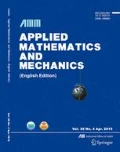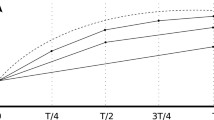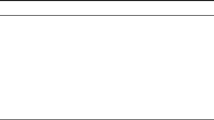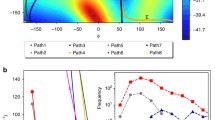Abstract
In this paper, we develop a modified accelerated stochastic simulation method for chemically reacting systems, called the “final all possible steps” (FAPS) method, which obtains the reliable statistics of all species in any time during the time course with fewer simulation times. Moreover, the FAPS method can be incorporated into the leap methods, which makes the simulation of larger systems more efficient. Numerical results indicate that the proposed methods can be applied to a wide range of chemically reacting systems with a high-precision level and obtain a significant improvement on efficiency over the existing methods.
Similar content being viewed by others
References
McAdams H H, Arkin A. Stochastic mechanisms in gene expression[J]. Proc Natl Acad Sci U.S.A., 1997, 94(3):814–819.
Arkin A, Ross J, McAdams H H. Stochastic kinetic analysis of developmental pathway bifurcation in phage λ-infected E. coli cells[J]. Genetics, 1998, 149(4):1633–1648.
Fedoroff N, Fontana W. Small numbers of large molecules[J]. Science, 2002, 297(5584):1129–1130.
van Kampen N G. Stochastic process in physics and chemistry[M]. Amsterdam: North-Holland Publishing Company, 1981.
Gillespie D T. A general method for numerically simulating the stochastic time evolution of coupled chemical reactions[J]. J Comput Phys, 1976, 22(4):403–434.
Gillespie D T. Exact stochastic simulation of coupled chemical reactions[J]. J Chem Phys, 1977, 81(25):2340–2361.
Gibson M, Bruck J. Efficient formulation of the stochastic simulation algorithm for chemically reacting systems[J]. J Chem Phys, 2000, 104(9):1876–1889.
McCollum J M, Peterson G D, Cox C D, Simpson M L, Samatova N F. The sorting direct method for stochastic simulation of biochemical systems with varying reaction execution behavior[J]. Comput Biol Chem, 2006, 30(1):39–49.
Gillespie D T. Approximate accelerated stochastic simulation of chemically reacting systems[J]. J Chem Phys, 2001, 115(4):1716–1733.
Gillespie D T, Petzold L R. Improved leap-size selection for accelerated stochastic simulation[J]. J Chem Phys, 2003, 119(16):8229–8234.
Rathinam M, Petzold L R, Cao Y, Gillespie D T. Stiffness in stochastic chemically reacting systems: the implicit tau-leaping method[J]. J Chem Phys, 2003, 119(24):12784–12794.
Tian T, Burrage K. Binomial leap methods for simulating stochastic chemical kinetics[J]. J Chem Phys, 2004, 121(21):10356–10364.
Chatterjee A, Vlachos D G, Katsoulakis M A. Binomial distribution based τ-leap accelerated stochastic simulation[J]. J Chem Phys, 2005, 122(2):024112.
Peng X J, Zhou W, Wang Y F. Efficient binomial leap method for simulating chemical kinetics[J]. J Chem Phys, 2007, 126(22):224109.
Cai X D, Xu Z Y. K-leap method for accelerating stochastic simulation of coupled chemical reactions[J]. J Chem Phys, 2007, 126(7):1.
Auger A, Chatelain P, Koumoutsakos P. R-leaping:Accelerating the stochastic simulation algorithm by reaction leaps[J]. J Chem Phys, 2006, 125(8):084103.
Lipshtat A. “All possible steps” approach to the accelerated use of Gillespie’s algorithm[J]. J Chem Phys, 2007, 126(18):184103.
Cao Y, Gillespie D T, Petzold L R. Efficient step size selection for the tau-leaping simulation method[J]. J Chem Phys, 2006, 124(4):044109.
Cao Y, Petzold L R. Accuracy limitations and the measurement of errors in the stochastic simulation of chemically reacting systems[J]. J Comput Phys, 2006, 212(1):6–24.
Cao Y, Li H, Petzold L R. Efficient exact stochastic simulation algorithm for chemically reacting systems[J]. J Comput Phys, 2004, 121(9):4059–4067.
Cao Y, Gillespie D T, Petzold L R. Avoiding negative populations in explicit Poisson tau-leaping[J]. J Chem Phys, 2005, 123(5):054104.
Author information
Authors and Affiliations
Corresponding author
Additional information
Communicated by GUO Xing-ming
Project supported by the National Natural Science Foundation of China (No. 30571059), the National High-Tech Research and Development Program of China (No. 2006AA02Z190).
Rights and permissions
About this article
Cite this article
Zhou, W., Peng, Xj., Liu, X. et al. “Final all possible steps” approach for accelerating stochastic simulation of coupled chemical reactions. Appl. Math. Mech.-Engl. Ed. 29, 379–387 (2008). https://doi.org/10.1007/s10483-008-0309-x
Received:
Revised:
Published:
Issue Date:
DOI: https://doi.org/10.1007/s10483-008-0309-x




